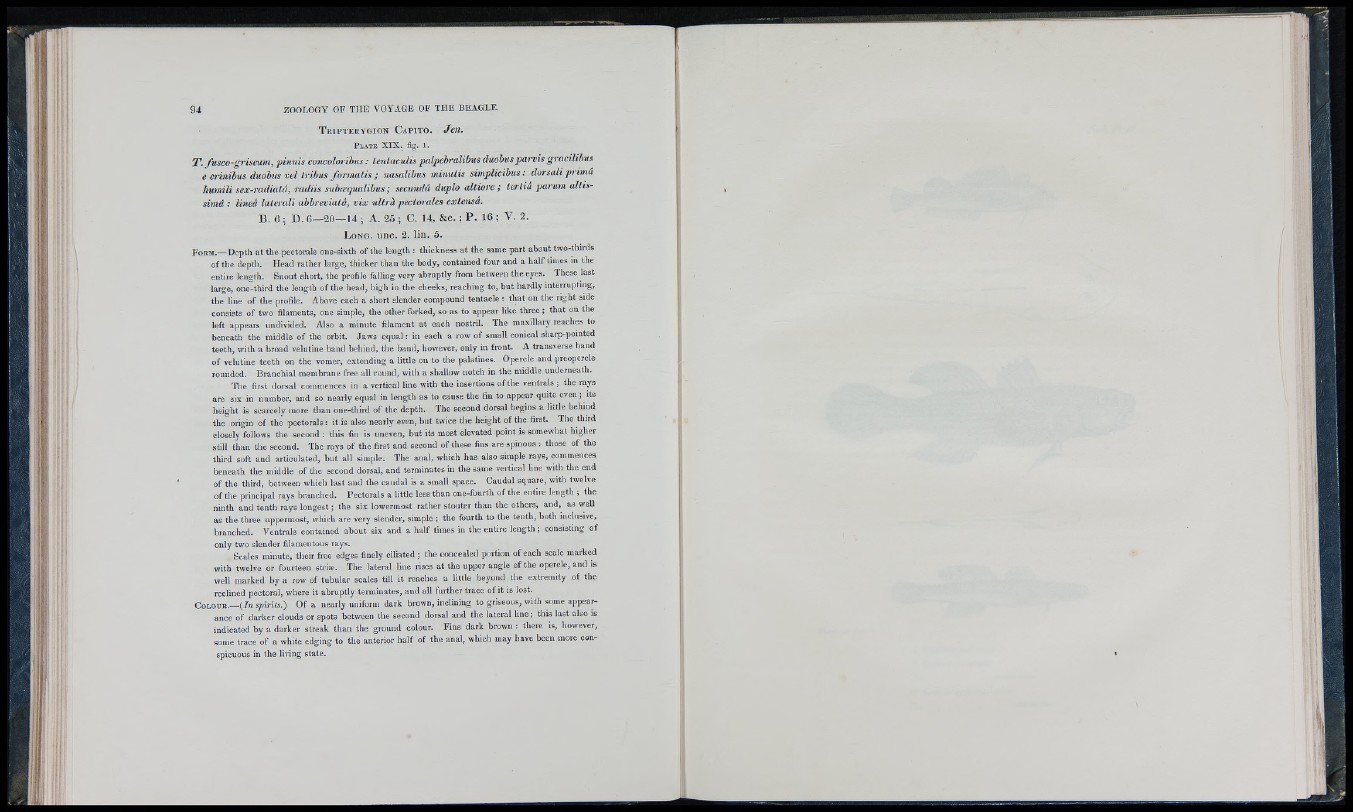
T r ip t e r y g io n C a p i t o . Jen.
P l a t e XIX . f i g . 1 .
T . fusco-griseum, pinnis concoloribns : tentaculis pyalpehralibus duobus parvis gracilibus
e crinibus duobus vel tribtis formatis ; nasalibus minutis simplicibus : dorsali prima
humili sex-radiat(i, radiis suboequalibus ; secunda duplo altiore ; tertiâ parum altis-
simâ: lined laterali abbreviatâ, vix xiltrà pectorales extensâ.
B. 0 : D. 6—20—14 ; A. 25 ; C. 14, &c. ; P . 16 ; V. 2.
L o n g . u n c . 2 . lin . 5.
F o r m .— D epth at the pectorals one-sixth of the length : thickness at the same part about two-thirds
of the depth. Head rather large, thicker than the body, contained four and a h alf times in the
entire length. Snout short, the profile falling very abruptly from between the eyes. These last
large, one-third the length of the head, high in the cheeks, reaching to, but hardly interrupting,
the line of the profile. Above each a short slender compound tentacle : th a t on the right side
consists of two filaments, one simple, the other forked, so as to appear like three ; that on the
left appears undivided. Also a minute filament a t each nostril. The maxillary reaches to
beneath the middle of the orbit. Jaw s equal : in each a row of small conical sliarp-pomted
teeth, with a broad velutine band behind, the band, however, only in front. A transverse band
of velutine teeth on the vomer, extending a little on to the palatines. Opercle and preopercle
rounded. B ranchial membrane free all round, with a shallow notch in the middle underneath.
The first dorsal commences in a vertical line with the insertions of the ventrals ; the rays
are six in number, and so nearly equal in length as to cause the fin to appear quite even; its
height is scarcely more than one-third of the depth. The second dorsal begins a little behind
the origin of the pectorals : it is also nearly even, but twice the height of the first. The third
closely follows the second : this fin is uneven, but its most elevated point is somewhat higher
still than the second. The rays of the first and second of these fins are spinous : those of the
third soft and articulated, but all simple. The anal, which has also simple rays, commences
beneath the middle of the second dorsal, and terminates m the same vertical line with the end
of the third, between which last and the caudal is a small space. C audal square, with twelve
of the principal rays branched. Pectorals a little less than one-fourth of the entire length ; the
ninth and tenth rays longest ; the six lowermost rather stouter than the others, and, as well
as the three uppermost, which are very slender, simple ; the fourth to the tenth, both inclusive,
branched. V entrals contained about six and a half times in the entire length ; consisting of
only two slender filamentous rays.
Scales minute, their free edges finely ciliated ; the concealed portion of each scale marked
with twelve or fourteen striæ. The lateral line rises a t the upper angle of the opercle, and is
well marked by a row of tubular scales till it reaches a little beyond the extremity of the
reclined pectoral, where it abruptly terminates, and all further trace of it is lost.
C o lo u r.— (Jn spirits.) O f a nearly uniform dark brown, inclining to griseous, witli some appearance
of darker clouds or spots between the second dorsal and the lateral line; this last also is
indicated by a darker streak than the ground colour. Fins dark brown : there is, however,
some trace of a white edging to the anterior half of the anal, which may have been more conspicuous
in the living state.